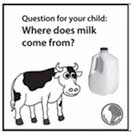|

 |
How To Spark
Learning Everywhere Kids Go
Starting With The Supermarket
Anya Kamenetz
Picture this: You're in the supermarket with your hungry preschooler in
tow. As you reach into the dairy case, you spot a sign with a friendly
cartoon cow. It reads: "Ask your child: Where does milk come from? What
else comes from a cow?"
In a small study published last year, signs like these, placed in
Philadelphia-area supermarkets, sparked a one-third increase in
conversations between parents and children under 8.
The extra family chatter happened only in low-income neighborhoods.
Research shows that's exactly the place where it's needed most: Studies
have documented a "word gap" that can lead, ultimately, to poor kids
starting school months behind in language development.
The total cost of the intervention? About $20 per grocery store.
The supermarket study is one seed of a much bigger idea about creating
opportunities for children to learn in the wider world; to leverage
caregivers as teachers and, in the process, try to level out stubborn
inequities.
Here at NPR Ed, for example, most of our stories are set in classrooms.
But children spend only 20 percent of their waking time, if they're
lucky, in formal classroom settings.
That gap — not in our coverage, but in the education community in
general — bothers Brenna Hassinger-Das, a postdoctoral fellow at the
Temple University Infant & Child Laboratory, which conducted the
supermarket study (Katherine Ridge was the lead author).
"We devote so much of our time and energy to reforming school, when you
realize how small a percentage of time students spend there. How can we
have a faster impact by getting resources right to where people are?"
Versions of the supermarket project are being tried in Tulsa, Okla.,
and Johannesburg. And at home in Philly, Hassinger-Das is working with
supermarket study coauthors Kathy Hirsh-Pasek and Roberta Michnik
Golinkoff, the authors of Becoming Brilliant, on a bigger answer to
that question: a pilot project called Urban Thinkscape.
By next April, Urban Thinkscape will place five different
installations, resembling children's museum exhibits, in an
underutilized piece of public space next to a bus stop in West
Philadelphia. The bus-shelter bench becomes a giant puzzle. A rotating
shade with cutouts turns a streetlight into a display of animation. A
hopscotch-like sidewalk inlay is actually based on a common test of
"executive functioning" — helping kids practice when to act and when to
inhibit action.
"Families don't have to travel or pay to get in," says Hassinger-Das.
"The focus is on increasing their interactions and the way they talk to
each other."
She's training local residents to unobtrusively collect data on site.
"We're testing things like conversational turn-taking between parents
and children, and the use of spatial words and number words."
They want to explore whether the installations are captivating enough
to keep caregivers off their phones. And they'll also be doing surveys
to see whether the experience shifts parents' attitudes, in particular
about the connection between play and learning.
Finally, she says, they're even toying with using something called a
"laughometer" — really! — to measure, "Are people happy in this space?"
The idea is more than just brightening up a dull commute. It's bringing
playful learning experiences to families that may not otherwise have
the resources or knowledge to seek them out. Hassinger-Das and her team
have future plans to bring Urban Thinkscape to other "trapped spaces"
in the city, like doctors' waiting rooms and laundromats.
|
|
|
|

